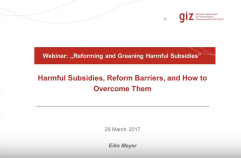
This report presents the results of the integration of public and private expenditure on climate change over the period 2014-2017, both constitute the total climate financing for Guatemala. The objective of this report is to create relevant information for decision making and the allocation of resources by public and private actors in order to align expenses to an efficient prioritization according to the environment status and the defined sectorial goals. The National Action Plan on Climate Change was used to guide and organize the information. The results showed that the main executing institutions of the expenditure are: five public institutions (MARN, MAGA, CONAP, INAB, CONRED) and two private sector components (international cooperation and private sector). The most important source of financing for climate change comes from loans from the national financial sector to the private sector (Q 4,220.91 million). The second source corresponds to external loans to the private sector (Q 4,206.36 million), followed by the private sector’s resources (Q 3,687.58 million). The fourth source comes from the public sectors and from the current income, particularly from taxes collection (Q 1,830.79 million); The fifth source of financing is made up of external donations from the international cooperation (Q 969.71 million). The national expenditure on climate change for the period 2014-2017 is equivalent to Q 15,661.67 million, 84% of this amount was allocated to mitigation actions and the remaining 16% was allocated to adaptation actions. By relating this information with the GDP, the total national expenditure on climate change remains on 0.77% of GDP. Finally, the report also identifies that measurement of private expenditure on climate change presents greater methodological and institutional challenges than the measurement of public expenditure.



